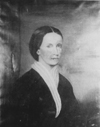Jane Grey Swisshelm
Jane Grey Swisshelm, renowned abolitionist and 19th century journalist, on gardening on the family estate in the valley of Nine Mile Run:
"Much of the natural beauty of Swissvale had been destroyed by pioneer improvements, which I sought in some degree to replace. I loved the woods, and with my little grubbing-hoe transplanted many wild and beautiful things. This my mother-in-law did not approve, as her love for the beautiful was satisfied by a flower border in the garden."
Half a Century, by Jane Grey Swisshelm
(Chicago: Jansen, McClurg & Company, 1880) pg. 78.
United States Steel Corporation formed
"There is no secret about success; it simply calls for hard work, devotion to your business at all times, day and night."
Triumphant Capitalism : Henry Clay Frick and the Industrial Transformation of America by Kenneth Warren (Pittsburgh : University of Pittsburgh Press, 1996) pg. 332
Mayor George Guthrie appoints a reformist Civic Commission
The Civic Commission sponsors a plan for the City’s parks and boulevards, prepared by Frederick Law Olmsted, Jr. The Olmsted report, completed in 1911, identifies Nine Mile Run as the "most striking opportunity…for a large park."
Frederick Law Olmsted, Jr. on the potential for a Nine Mile Run park:
"Its long meadows of varying width would make ideal playfields; the stream, when it is freed from sewage, will be an attractive and interesting element in the landscape; the wooded slopes on either side give ample opportunity for enjoyment of the forest, for shaded walks and cool resting places; and above all it is not far from a large working population in Hazelwood, Homestead, Rankin, Swissvale, Edgewood, Wilkinsburg, Brushton and Homewood."Pittsburgh, Main Thoroughfares and the Down Town District, 1911
The city chooses not to invest in sewage treatment
The justification was that it would be cheaper for down-river communities to treat their drinking water than for Pittsburgh to construct sewage treatment.
Building of Regent Square plan of homes begins, fronting on the "big 100 acre Frick Forest"
Promotional materials for the plan states that:
This beautiful woodland has long been talked of as a future city park and persons who are well informed confidently assert that there is little doubt that eventually this valuable property will come into possession of the city as still another breathless spot for the people. Even as is it is, however, it is a thing of beauty and a joy to natives of Regent Square and a royal playground for the children.
"In Frick Park man had already accomplished much of the destruction to the plant and animal life before the region became a city park. Collecting, picking, hunting dumping and sewage had eliminated many of the plants and animals. Open sewage was flowing down Falls Ravine and Fern Hollow before 1915. Any depression or valley was an accepted site for dumping refuse and dirt from building and street construction."
William LeRoy Black, M.S. University of Pittsburgh In the Doctoral thesis,
The Ecology of a City Park, Frick Park, Pittsburgh Pa. 1947
The Citizens’ Committee on City Plan formed
In 1923, the Citizens’ Committee on City Plan issued its report on parks, recommending that the Nine Mile Run Valley be a water-oriented park with a range of recreational facilities.
The Citizens' Committee recommendation for Nine Mile Run:
"To those who hold that the needs of industries and manufacturing concerns should be supplied in the valley, the Committee cites the utmost importance of the present proposal for the recreation of a very great working population in the metropolitan district. It is significant that the population withing a reasonable distance of this valley is, according to the 1920 census, about 220,000."Parks: A Part of the Pittsburgh Plan. Report no. 4, Citizens Committee on City Plan of Pittsburgh. September 1923.
Andrew Carnegie and Henry Clay Frick die five months apart
"The demands of modern life…called for such work as ours; and if we had not met the demand others would have done so. Even without us the steel industry of the country would have been just as great as it is, though men would have used other names when speaking of its leaders."
Henry Clay Frick : an Intimate Portrait by Martha Frick Symington Sanger (New York : Abbeville Press Publishers, 1998) pg. 381.
"There is surely to arise from the wealth created here a body of men who will find in the distribution of their gains where they were made, the genuine reward which surplus wealth can give. The knowledge that it is certain in after years to elevate, refine, and purify the lives of those who succeed us, and that we have left a spot of earth at least a little better than we have found it.
The highest type of humanity, believe me, is that which does most to make our earthly home a heaven. The highest worship of God is service to man."
Andrew Carnegie (1907) Memorial of the Celebration of the Carnegie Institute. Notes from the Address by Andrew Carnegie.
"Tell Mr. Carnegie I'll see him in hell."
From Henry Clay Frick : the Gospel of Greed by Samuel A. Schreiner, Jr.
(New York : St. Martin's Press, 1995), pg. ix.
Frick’s will deeds 159 acres and $2 million to the City
"I GIVE AND BEQUETH to THE UNION TRUST COMPANY OF PITTSBURGH, of the City of Pittsburgh, Pennsylvania, as Trustee, the sum of TWO MILLION DOLLARS, IN TRUST, to hold the same as a trust fund for the maintenance of the said park, and to invest and reinvest the same and to collect and receive the income thereof, and after paying the expenses of the trust, including a reasonable compensation to the said trustee, to pay and apply the residue of the said income to maintaining, improving, embellishing and adding to the said park and keeping the same in proper condition."
Henry Clay Frick Will, Article V (1919)
Frick funds used to purchase the Swisshelm estate.
The Pittsburgh Parks and Playground Society founded
The Parks and Playground Society was formed to improve the City’s parks, outdoor amenities, and recreation opportunities. Its recent program focus has been urban gardens and community greening.
Allegheny Conference on Community Development established
Recommendations for Frick Park
- Remove the contaminants in Nine Mile Run, and prevent their return.
- Increase the amount of water available to plants and animals by (a) blocking the passage of surface streams into sewers; (b) Building artificial pools and check dams; (c) Constructing trails and other works so as not interfere with water tables.
- Replant as much of the original type of flora as possible; introduce other plants to take the place of the native flora that will not survive; and remove no dead trees or underbrush because they provide additional escape and nesting cover.
- Control or stop human traffic in those areas susceptible to erosion and abnormal wear and tear by (a) Temporarily closing off areas; (b) Removing trails from critical areas; (c) Planting dense shrubbery along the trails, especially at the loops, to discourage "short cuts."
- Institute nature recreation programs in individual city parks to make individuals conservation conscious; and intensify publicity and nature education of children in schools and parks throughout the city, with special emphasis on leaving everything just as it is.
William LeRoy Black, M.S. University of Pittsburgh In the Doctoral thesis,
The Ecology of a City Park, Frick Park, Pittsburgh Pa. 1947
Allegheny County Sanitary Authority formed as a municipal authority
The Parkway East’s Commercial Street Bridge completed
"Holing through" of the Squirrel Hill Tunnel
"In some instances, valuable property has been made available by filling wasteland with slag. The use of slag as a commercial product conserves natural resources."
U.S. Department of the Interior, Bureau of Mines (1949), Iron Blast-Furnace Slag: Production, Processing, Properties and Uses.
Duquesne Slag ceases the rail disposal of slag and shifts entirely to barges
The Swisshelm Park Civic Association challenges the new use of the riverfront and succeeds in receiving concessions from Duquesne Slag. In 1954 the Swisshelm Park Civic Association petitions City Council . When Duquesne Slag fails to satisfy any of the conditions it had agreed to four years earlier, the City takes no action.
Greater Pittsburgh Parks Association is transformed into the Western Pennsylvania Conservancy
The initial mission of the Conservancy was to implement regional park development recommendations of the Parks and Recreation Committee of the Allegheny Conference on Community Development, leading to the creation of state parks such as McConnells Mills and Ohiopyle.
The City enacts a new zoning statute
The entire Nine Mile Run valley was zoned for special use, a designation reserved for areas, including steep slopes and undermined lands, where future development is subject to additional public scrutiny.
Alterations by Man
The results of the alterations by man in Frick Park are many, schools, houses, industrial installations, streets and sidewalks were constructed around the natural ravines. Storm and sewage sewers from these communities emptied their contents into the Falls Ravine, Fern Hollow and the Nine Mile Run Hollow. To contain the sewage, more sewers were built. These sewers followed the stream channels, altering the creek beds and the entire drainage system. The runoff from streets, open storm sewers, and small gullies filled the stream channels with debris, and cut deep gullies in the hillsides washing away the plants, soil, clay, and stones.William LeRoy Black, M.S. University of Pittsburgh In the Doctoral thesis,
The Ecology of a City Park, Frick Park, Pittsburgh Pa. 1947
The Department of City Planning develops a broad woodlands program
The program proposes to set aside tax-delinquent properties to expand the City’s open space system. Nine Mile Run was identified as a long term opportunity.
City releases a development study for the slag pile
The study presented the possibilities for residential and light industrial development on the slag pile, including open space and a path connecting Frick park to the Monongahela River, but could not attract a developer.
"I think that this is one of the cities that has made America strong through the whole century. It's probably at a low ebb right now and the country is going through a transition from a blue collar to a white collar but Pittsburgh is synonymous with Steelers, It is synonomous with a steel town."
Richard Serra being interviewed by Vicky Clark.
An unpublished interview. Nov. 1985
J.J. Gumberg Company obtained an option to buy the site
The Company proposed to build a shopping and office center on the site. The proposal was defeated in part due to community opposition to the traffic it would attract and a requirement for a new road.
Squirrel Hill Urban Coalition releases its Neighborhood Plan
The Neighborhood Plan includes residential development on the slag with an extension of Frick Park to the Monongahela River
The Pittsburgh Parks Conservancy formed
The Pittsburgh Parks Conservancy is a non-profit organization dedicated to the restoration and revitalization of Schenley, Frick, Highland and Riverview parks.
Public hearings and community meetings on the residential development
Heinz Endowment funds the Nine Mile Run Greenway Project’s Community Dialogue on brownfields and open space
Three Rivers Wet Weather Demonstration Program initiated as a joint program of ALCOSAN and the Allegheny County Health Department
The Demonstration Program is a federal-local partnership to develop, demonstrate, and implement cost-effective solutions to remedy sanitary sewer overflows throughout Allegheny County. Program activities include a Nine Mile Run Aquatic Habitat Restoration Project administered by the Army Corps of Engineers.













